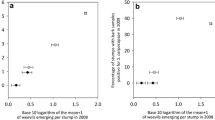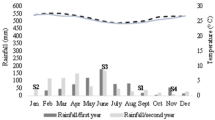Abstract
A population of the citrus nematode Tylenchulus semipenetrans Cobb (Tylenchida: Tylenchulidae) associated to a Pasteuria sp. (Bacillales: Bacillaceae) was studied in a naturally infested field. In a first population dynamics study, prevalence never exceed 50 % and showed a density-dependent relationship with the host at 2–3 months time lags, with a spring sharp increase. In a spatial sampling study, both organisms resulted uniformly distributed and matched the observed relationship. In top (10 cm) soil the adult females were lower than in deeper layers, whereas the nematodes with adhering endospores were higher. Anderson and May’s Model G applied showed that 50–400 endospores per cc of soil can sustain stable regulatory cycles. The nematode and bacterium populations were found in the field 12 years later with declining densities, below the calculated threshold needed to maintain the parasite infection. Data confirmed the bacterium potential in nematode regulation and showed that host numbers affect prevalence changes in time.





Similar content being viewed by others
References
Anderson RM, May RM (1981) The population dynamics of microparasites and their invertebrate hosts. Phil Trans R Soc London 291:451–524
Atibalentja N, Noel GR, Liao TF, Gertner GZ (1998) Population changes in Heterodera glycines and its bacterial parasite Pasteuria sp. in naturally infested soil. J Nematol 30:81–92
Ciancio A (1995) Density-dependent parasitism of Xiphinema diversicaudatum by Pasteuria penetrans in a naturally infested field. Phytopathology 85:144–149
Ciancio A, Quénéhervé P (2000) Population dynamics of Meloidogyne incognita and infestion levels by Pasteuria penetrans in a naturally infested field in Martinique. Nematropica 30:77–86
Ciancio A, Roccuzzo G (1992) Observations on a Pasteuria sp. parasitic in Tylenchulus semipenetrans. Nematologica 38:403–404
Ciancio A, Mankau R, Mundo-Ocampo M (1992) Parasitism of Helicotylenchus lobus by Pasteuria penetrans in naturally infested soil. J Nematol 24:29–35
Dabiré RK, Ndiaye S, Mounport D, Mateille T (2007) Relationships between abiotic soil factors and epidemiology of the biocontrol bacterium Pasteuria penetrans in a root-knot nematode Meloidogyne javanica-infested field. Biol Control 40:22–29
Davies KG, Redden M (1997) Diversity and partial characterization of putative virulence determinants in Pasteuria penetrans, the hyperparasite of root-knot nematodes. J Appl Microbiol 83:227–235
Davies KG, Flynn CA, Laird V, Kerry BR (1990) The lifecycle, population dynamics and host specificity of a parasite of Heterodera avenae, similar to Pasteuria penetrans. Rev Nématol 13:303–309
Duncan LW, Noling JW (1987) The relationship between development of the citrus root system and infestation by Tylenchulus semipenetrans. Rev Nématol 10:61–66
Fattah FA, Saleh HM, Aboud HM (1989) Parasitism of the citrus nematode, Tylenchulus semipenetrans, by Pasteuria penetrans in Iraq. J Nematol 21:431–433
Gaspard JT, Mankau R (1986) Nematophagous fungi associated with Tylenchulus semipenetrans and the citrus rhizosphere. Nematologica 32:359–363
Gressel J (2005) Problems in qualifying and quantifying assumptions in plant protection models: resultant simulations can be mistaken by a factor of million. Crop Prot 24:1007–1015
Hassell MP (1978) The dynamics of arthropod predator-prey systems. Princeton University Press, Princeton
Jaffee BA, McInnis TM (1991) Sampling strategies for detection of density-dependent parasitism of soil-borne nematodes by nematophagous fungi. Rev Nematol 14:147–150
Jaffee B, Phillips R, Muldoon A, Mangel M (1992) Density-dependence host–pathogen dynamics in soil microcosms. Ecology 73:495–506
Kaplan DT (1994) Partial characterization of a Pasteuria sp. attacking the citrus nematode, Tylenchulus semipenetrans, in Florida. Fundam Appl Nematol 17:509–512
Luc JE, Pang W, Crow WT, Giblin-Davis RM (2010) Effects of formulation and host nematode density on the ability of in in vitro-produced Pasteuria endospores to control its host Belonolaimus longicaudatus. J Nematol 42:87–90
Mateille T, Fould S, Dabiré KR, Diop MT, Ndiaye S (2009) Spatial distribution of the nematode biocontrol agent Pasteuria penetrans as influenced by its soil habitat. Soil Biol Biochem 41:303–308
McSorley R, Dankers WH, Parrado JL, Reynolds JS (1985) Spatial distribution of the nematode community on perrine marl soil. Nematropica 15:77–92
Noel GR, Atibalentja N, Domier LL (2005) Emended description of Pasteuria nishizawae. Int J Syst Evol Microbiol 55:1681–1685
Oostendorp M, Dickson DW, Mitchell DJ (1991) Population development of Pasteuria penetrans on Meloidogyne arenaria. J Nematol 23:58–64
Sorribas FJ, Verdejo-Lucas S, Forner JB, Alcaidel A, Pons J, Ornat C (2000) Seasonality of Tylenchulus semipenetrans Cobb and Pasteuria sp. in citrus orchards in Spain. J. Nematol 32:622–632
Sorribas FJ, Verdejo-Lucas S, Pastor J, Ornat C, Pons J, Valero J (2008) Population densities of Tylenchulus semipenetrans related to physicochemical properties of soil and yield of clementine mandarin in Spain. Plant Dis 92:445–450
Stirling G (2014) Biological control of plant-parasitic nematodes, 2nd edition. Soil ecosystem management in sustainable agriculture. CABI, Oxfordshire
Verdejo Lucas S (1992) Seasonal population fluctuations of Meloidogyne spp. and the Pasteuria penetrans group in kiwi orchards. Plant Dis 76:1275–1279
Acknowledgments
Research partially funded by MiPAF, PF Lotta biologica, PF Orticoltura and Project BIOMED. The authors thank R. Bonsignore, A. Loffredo and L. C. Rosso for the assistance provided during this study. The Universitat Politecnica de Catalunya and CNR are gratefully acknowledged for short-term mobility grants (CO).
Author information
Authors and Affiliations
Corresponding author
Additional information
Handling Editor: Francisco Cazorla.
An erratum to this article is available at http://dx.doi.org/10.1007/s10526-017-9786-z.
Rights and permissions
About this article
Cite this article
Ciancio, A., Roccuzzo, G. & Longaron, C.O. Regulation of the citrus nematode Tylenchulus semipenetrans by a Pasteuria sp. endoparasite in a naturally infested soil. BioControl 61, 337–347 (2016). https://doi.org/10.1007/s10526-015-9704-1
Received:
Accepted:
Published:
Issue Date:
DOI: https://doi.org/10.1007/s10526-015-9704-1




